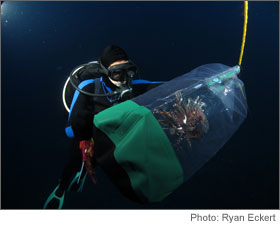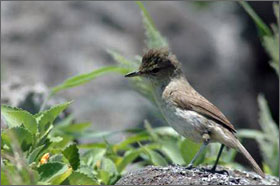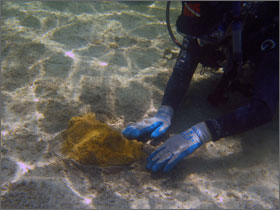|

Flower Garden Banks Sanctuary Responds to Invasive Lionfish
Natives of the Indo-Pacific, lionfish were introduced to the Caribbean in the 1990s and rapidly expanded their range into both the Atlantic and Gulf of Mexico. Due to the lionfish’s feeding habits and ability to reproduce rapidly, resource managers are concerned about their potential impacts on economically important species such as snapper and grouper, as well as other fish communities throughout the different habitats. When the first lionfish were sighted in Flower Garden Banks National Marine Sanctuary during summer 2011, staff began working with the local community to better understand and find solutions to the potential economic and ecological impacts of the invasion.
Shipping Lane Changes Proposed for Santa Barbara Channel
In May 2011, Channel Islands National Marine Sanctuary and NOAA Fisheries Service staff jointly provided the U.S. Coast Guard with whale-related information and recommendations for a local area Port Access Route Study. The study, published Nov. 1, contains recommendations that stem directly from input provided by NOAA, namely, to create traffic lanes south of the Channel Islands and decrease the width of the separation scheme in the Santa Barbara Channel to move lanes further from the sanctuary and known areas of seasonal whale concentration. A Coast Guard rulemaking process is expected to follow.

Nihoa Millerbirds Released, Offering Hope for Species Survival
In a historic and collaborative effort to save a species from extinction, 24 critically endangered Nihoa Millerbirds were successfully relocated from Nihoa Island to Laysan Island in Papahānaumokuākea Marine National Monument. The release was the result of many years of research and detailed planning by biologists and resource managers, led by a partnership between the U.S. Fish and Wildlife Service and the American Bird Conservancy. The translocation restores this insect-eating songbird to Laysan’s ecosystem; Millerbirds have been absent from the island for nearly 100 years after a closely related subspecies went extinct in the early 20th century.
Reducing Vessel Impacts on Whales in California Waters
A Joint Working Group on Acoustic Impacts and Vessel Strikes from Gulf of the Farallones and Cordell Bank sanctuary advisory councils is assessing how to reduce vessel impacts, such as harmful underwater noise and ship strikes on endangered blue, humpback and fin whales. Sanctuary management is working to minimize these risks while maintaining vital commerce. Large-class vessels make more than 6,000 transits yearly through Gulf of the Farallones National Marine Sanctuary while entering and leaving San Francisco Bay. The West Coast national marine sanctuaries are working together to address this critical issue.
Monument Celebrates World Heritage Status, 10 Years of Protection
Hundreds of conservation managers, marine scientists, conservation activists, political leaders and policy makers helped celebrate two globally significant milestones for Papahānaumokuākea Marine National Monument on Dec. 3, 2010. Highlighting the event was the commemoration of Papahānaumokuākea’s inscription on the UNESCO World Heritage List. High-level representatives from many government and international agencies participated in an official inscription ceremony to recognize Papahānaumokuākea as a place of universally outstanding natural and cultural features. The event also commemorated the 10th anniversary of the Northwestern Hawaiian Islands Coral Reef Ecosystem Reserve, established Dec. 4, 2000.

Restoration Team Reattaches 100 Corals at Florida Keys Vessel Grounding Site
Florida Keys National Marine Sanctuary staff completed work on a coral restoration project off Key Largo in summer 2011. The team reattached 100 corals, primarily boulder star coral that had been injured during the 2006 grounding of the 54-foot motor yacht Das Boot. The vessel had struck an area of shallow patch reefs, injuring approximately 8.7 square meters of reef framework. Damages recovered in the grounding case settlement were used to fund the restoration.
Joint Working Group Addresses Ship Strikes and Ocean Noise
Cordell Bank and Gulf of the Farallones national marine sanctuaries have been engaged in a working group process with research scientists, conservation groups, relevant agencies and the shipping industry on making recommendations to reduce ship strikes and evaluate ocean noise impacts in the sanctuaries. The Joint Working Group on Ship Strikes and Sound in the Sanctuaries will submit recommendations to the sanctuary advisory councils in fall 2012. The working group was initiated following four vessel strikes on endangered cetaceans in 2010.
Sister Sanctuary Links Expand throughout Atlantic Ocean
Stellwagen Bank National Marine Sanctuary’s sister sanctuary program increased its international cooperative efforts in 2011, as NOAA and France’s Protected Areas Agency signed an agreement to support the protection of endangered humpback whales that migrate annually between Stellwagen Bank and Agoa Marine Mammal Sanctuary in the French Antilles. Agoa becomes the second sister sanctuary in the Caribbean, joining the Marine Mammal Sanctuary of the Dominican Republic. Also in 2011, the government of Bermuda signed a Letter of Intent to establish a sister sanctuary relationship with Stellwagen Bank National Marine Sanctuary once Bermuda created a marine mammal protected area in its waters. These waters lie along humpback whales’ migratory route.
|



